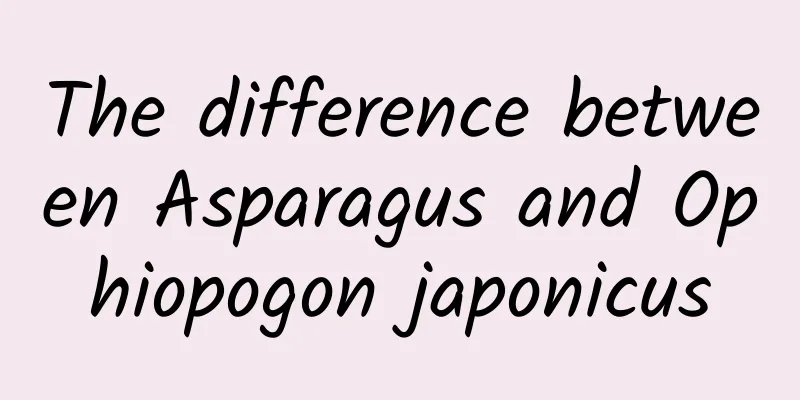The difference between Asparagus and Ophiopogon japonicus

|
What is the difference between Asparagus cochinchinensis and Ophiopogon japonicus? We must first analyze what Asparagus cochinchinensis is and what Ophiopogon japonicus is. What is asparagus? Asparagus is a herb. Its effects and functions are very comprehensive. It can nourish the lungs and kidneys. Ophiopogon japonicus also has very medicinal properties. We can use it to clear the heart, nourish the stomach and promote salivation. So what is the difference between Asparagus cochinchinensis and Ophiopogon japonicus? Only when we understand the difference between Asparagus cochinchinensis and Ophiopogon japonicus can we make rational use of these two herbs in the future. Otherwise, if they are confused, the different medicinal properties may cause many adverse effects. So let's take a look at the difference between Asparagus cochinchinensis and Ophiopogon japonicus below. (1) Appearance difference: Asparagus: A climbing plant with many branches growing in clusters and drooping. 80-120 cm long, the leaves are clustered and flat like pine needles, green and shiny, the leaf branches are usually clustered in 3, flat or slightly sharply triangular due to the keel shape of the midrib, slightly sickle-shaped, the scale-like leaf base on the stem extends into hard thorns 2.5-3.5 mm long, and the thorns on the branches are shorter or inconspicuous. Ophiopogon japonicus: grows in clumps. About 30 cm high. The leaves are clustered, slender, dark green, and shaped like leeks. (2)Berry differences: Asparagus berries: red when ripe. Ophiopogon berries: dark green or black-blue when ripe. (3) Color difference: Asparagus: The flowers are mostly white or light green. Ophiopogon japonicus: The flowers are lavender. (4) Source difference: Similarities: Both are perennial herbs of the Liliaceae family, and the medicinal parts are tuberous roots. Difference: Asparagus is the tuberous root of the climbing herb Asparagus cochinchinensis, and Ophiopogon japonicus is the tuberous root of the herb Ophiopogon japonicus. (5) Differences in properties: Similarities: Spindle-shaped. It is flexible, translucent and has longitudinal wrinkles. different: Asparagus: The tuber is long spindle-shaped or cylindrical, slightly curved, 4-18cm long and 0.5-2cm in diameter. The surface is yellowish-white or yellowish-brown, oily and translucent, with longitudinal grooves and fine wrinkles of varying depths. Occasionally there is yellow-brown skin that has not been removed completely, which is sticky and has a distinct central column. Ophiopogon japonicus: spindle-shaped, slightly pointed at both ends, 1.5 to 3 cm long and 0.3 to 0.6 cm in diameter. The surface is yellowish white or light yellow, translucent, and has fine longitudinal lines. The central column is small. The above article introduces what Asparagus cochinchinensis is and what Ophiopogon japonicus is. The above article introduces the functions and effects of these two herbs respectively. From the difference in appearance to the fruit, from the color of the flower to the medicinal properties, the difference between Asparagus cochinchinensis and Ophiopogon japonicus is introduced in detail. I believe that after reading this, you will know how to distinguish Asparagus cochinchinensis from Ophiopogon japonicus. |
<<: The effect of drinking wild chrysanthemum water
>>: How to eat Dendrobium candidum
Recommend
The efficacy and function of white ginseng
White ginseng is a type of ginseng. It is a raw s...
What are the effects of nail powder?
Modern Chinese medicine is being rediscovered by ...
The efficacy and function of bitter melon vine
I believe many people are familiar with the Chine...
The efficacy and function of Tujianqi
In modern life, everyone is very familiar with va...
A 20-year-old boy was diagnosed with cancer after having diarrhea for several days! Many young people have these habits...
Xiao Wang (pseudonym) just turned 20 After gradua...
The effect of drinking asparagus soaked in water
The rhizomes of many plants can be dried and used...
The efficacy and function of old white flower
Old white flower is a traditional Chinese medicin...
How to use Chinese medicine to replenish qi and blood?
Using traditional Chinese medicine to replenish q...
Don’t want to drink water and get microplastics? The easiest way is actually… | Environmental Trumpet
Hello everyone, this is the 6th issue of the Envi...
It is a magical medicine that stands tall in the wind and frost.
I remember there was a Chinese idiom in the past,...
The efficacy and function of cypress leaves
The nutritional value of the leaves of the ground...
How does exercise make people feel comfortable and relaxed?
《Cotton Swab Medical Science Popularization》 Peki...
The efficacy and function of Alito
Alito is something that many people are very fami...
The efficacy and function of leek lotus
Leek and lotus are something that many people are...









